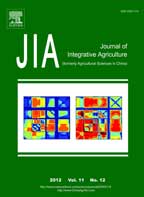|
|
GeneticAnalysisofEarlinessTraits inShortSeasonCotton (Gossypiumhirsutum L.)
SONG Mei-zhen, FAN Shu-li, YUAN Ri-hong, PANG Chao-you , YU Shu-xun
2012, 12(12):
1968-1975.
DOI: 10.1016/S1671-2927(00)8733
Inheritance and interrelationship of phenotype and genotype of earliness traits were evaluated in a diallel analysis involving six early-maturing parents. Date of first square (DFS), date of first flower (DFF), date of first open boll (DFOB), number of node first sympodial branch (NNFSB), and harvested rate before frost (HRBF) as earliness traits of six parents, 15 F1 hybrids and 15 F2 progenies were investigated from 2005 to 2008. The experiment design was a randomized complete block design with three replications. Additive, dominance and epistasis effects were analyzed with ADAA (additivedominance- epistasis) model. HRBF, DFF, and DFOB showed significant additive genetic variances. Heritability estimates ranged from 0.088 (HN, narrow sense) and 0.416 (HNE, environment interaction) for HRBF, to 0.103 (HN) and 0.524 (HNE) for DFF, and to 0.187 (HN) and 0.519 (HNE) for DFOB. Dominance genetic effects for DFS, DFF, DFOB, and NNSFB were stronger than additive effects. Additive-by-additive epistatic effects for DFS, DFOB, and NNSFB were detected and affected by environment. Correlation analysis showed generally that HRBF had a significant negative genetic and phenotypic correlation with DFS, DFOB, and NNFSB; DFS had significant positive genetic and phenotypic correlations with DFF, DFOB, and NNFSB; significant positive genetic and phenotypic correlations were also detected between DFF and DFOB, DFF and NNFSB, DFOB and NNFSB. The results showed that the lower the node to the first fruiting branch and the shorter the plant, the earlier was the onset of squaring, flowering, and boll opening, the higher was the harvest rate before frost. Heredity of earliness traits among parents and their hybrids were also detected and parents A1, A2, B1, B2, and B3 could be used to improve earliness traits of short season cotton cultivars.
|
